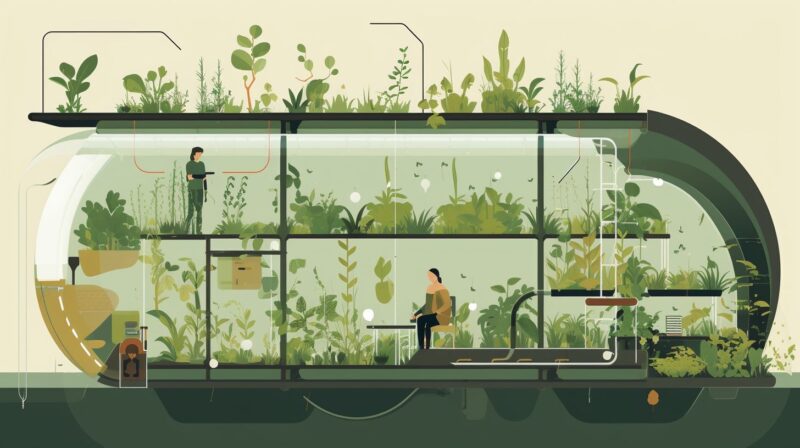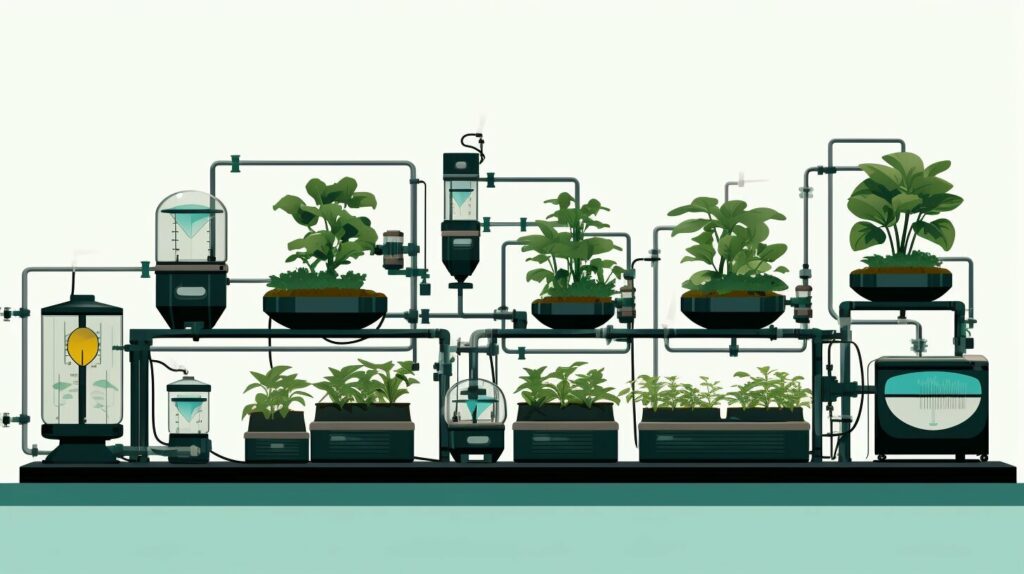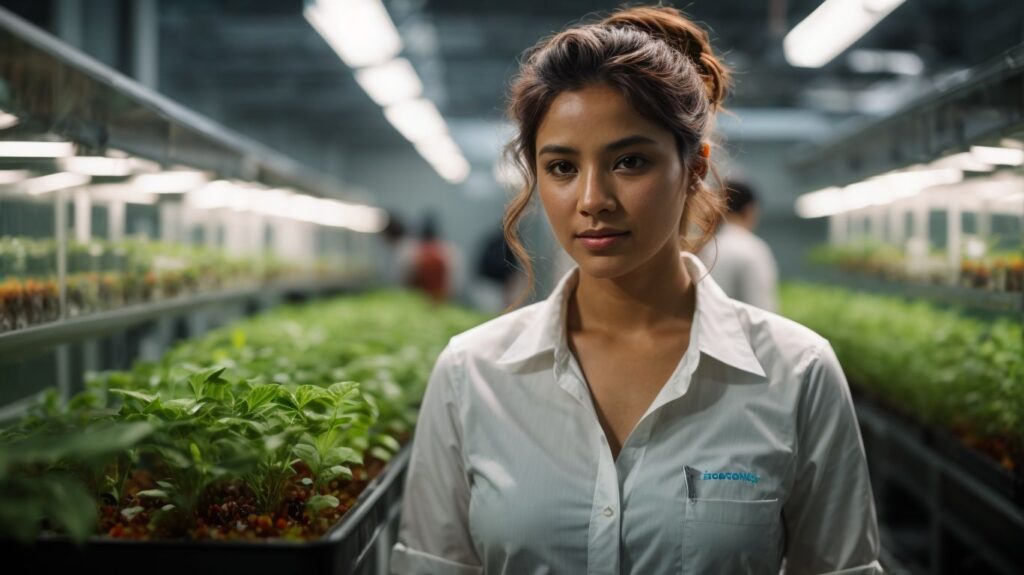This post may contain affiliate links and we may earn a small commission when you click on the links at no additional cost to you. As an Amazon Affiliate, we earn from qualifying purchases. You can read our full disclaimer here.
In an age marked by environmental challenges, sustainable agriculture has emerged as a beacon of hope for ensuring food security without compromising the health of our planet. Among the many innovative approaches to sustainable food production, aquaponics is a remarkable solution that marries aquaculture and hydroponics in a symbiotic system. This groundbreaking method not only maximizes food production but also minimizes environmental impacts.
In this comprehensive exploration of the impact of environmental factors on aquaponics, we delve into the science behind this system, its importance in modern agriculture, and its potential to mitigate the effects of climate change. We also discuss how water quality, hydroponics, and strategies for minimizing environmental damage play pivotal roles in the success of aquaponics. Additionally, we examine the evolving landscape of aquaponics in urban environments and its capacity to address pressing global issues.
As we journey through the various facets of aquaponics and its interactions with environmental factors, we gain insights into a sustainable farming approach that holds great promise. It offers an efficient way to produce food and contributes to reducing freshwater usage, lowering greenhouse gas emissions, and enhancing resilience in the face of a changing climate. However, we also acknowledge aquaponics’ challenges, including technical complexities and economic barriers. With a holistic perspective, we explore the potential and limitations of aquaponics, emphasizing its significance in the quest for a more environmentally sustainable and secure future for food production.
Key Takeaways
- Aquaponics is an innovative, sustainable food production system that combines aquaculture and hydroponics.
- It minimizes environmental impacts by using fish waste as a nutrient source for plants and recycling water.
- Aquaponics reduces water usage by up to 90% compared to traditional farming methods.
- It significantly lowers greenhouse gas emissions, making it an eco-friendly farming alternative.
- Aquaponics is resilient in climate change, with the potential for controlled indoor systems.
- Integration of aquaponics into urban agriculture can maximize food production in limited spaces.
- Technical challenges, setup costs, and market acceptance hinder wider adoption.
- Aquaponics represents a crucial step toward sustainable and environmentally friendly food production.
Understanding Aquaponics and its Importance
Aquaponics is an innovative and efficient production system that marries aquaculture and hydroponics. It is a symbiotic system where plants and fish are raised together in a managed setting. The aquaponics system utilizes waste from the fish as a nutrient source for the plants, which in turn filter and clean the water that gets recirculated back to the fish. In this way, aquaponics stands as one of the most sustainable food production options while minimizing environmental impacts.
Having its roots in ancient cultivation practices, aquaponics evolved as a solution to the environmental challenges posed by traditional fish farming and hydroponics. These older methods often involve high water usage and can risk nutrient pollution of water bodies. In contrast, an aquaponic system drastically reduces water use and virtually eliminates the risk of nutrient runoff. Aquaponics is an important tool for food production and environmentally sustainable practices in the modern world. Herein lies the importance of understanding and embracing aquaponics in today’s pressing times.
The Science Behind Aquaponic Systems
Aquaponic systems represent a symbiotic relationship between fish and plants, offering a sustainable food-growing method while minimizing waste. Here’s how it works: fish, such as tilapia, are grown in large tanks. Fish waste, high in ammonia, gets filtered out of the water and passed to a hydroponic system where bacteria break it down into nitrates, a perfect fertilizer for plants. In turn, the plants, ranging from herbs like basil to vegetables like lettuce, purify the water by absorbing the nitrates before it’s recirculated back to the fish tanks.
Commercial aquaponics is a potential solution for sustainable food production, particularly in areas with poor land space or soil quality. The system provides the dual benefit of producing plant and aquatic food in a single integrated system. Furthermore, it significantly reduces freshwater usage compared to traditional farming methods and averts the environmental contamination often associated with aquaculture systems. Additionally, since aquaponics requires less arable land and the water is recycled within the system, it reduces energy consumption and CO2 emissions, promoting environmental sustainability. Repurposing waste products and reducing emissions could be pivotal in pursuing more environmentally friendly food production methods.
The Link Between Environmental Factors and Aquaponics

Raft aquaponics is one of the farming techniques gaining recognition within the small-scale, sustainable agriculture industries. The Food and Agriculture Organization of the United Nations (FAO) acknowledges this system as a viable solution to several environmental challenges plaguing conventional agriculture. One critical aspect of this is water use, as aquaponic systems typically require 90% less water than traditional farming methods, making them excellent choices in areas where water scarcity is a pressing concern.
In addition to being water-efficient, aquaponics also substantially reduces greenhouse gas emissions. According to the Agriculture Organization of the United Nations, conventional farming methods significantly contribute to carbon dioxide and methane emissions, two gases that play an enormous role in global warming. However, since aquaponics systems utilize natural resources more efficiently – requiring less water and land – it can produce the same amount of food as traditional farming but with a much smaller carbon footprint.
How Water Quality Influences Aquaponic Systems
Water quality plays a pivotal role in the functioning and success of a small-scale aquaponics system. One main aspect of this is the life cycle assessment (LCA), which evaluates a product’s or process’s environmental impact over its entire lifespan. In the case of aquaponics, LCA can provide significant insights into the system’s performance and any potential improvements. Particularly, it can help optimize the hydroponic system, a fundamental component responsible for the growth and health of the plants. Good water quality also supports the environmentally friendly nature of these farming systems, reducing the demand for artificial fertilizers and pesticides.
Joining forces with conventional farming methods can contribute to the overall sustainability of global food production systems. The combination can generate higher yields on smaller land footprints while minimizing negative environmental impacts. Incorporating raft aquaponics as an arm of traditional farming strategies is particularly effective. It improves water utilization, reduces waste, and fosters synergistic interaction between fish and plants. Thus, water quality influences not only the efficiency of food production in aquaponics but also its potential to become a more widespread, feasible, and sustainable alternative to solely conventional farming.
Role of Hydroponics in an Aquaponic System
Hydroponics, where plants are grown in nutrient-rich water instead of soil, plays a vital role in the functioning and success of an aquaponic system. By using a technique known as small-scale raft aquaponics, the usage of water and waste can be significantly minimized, contributing greatly to reducing the environmental footprint. This method also allows plants and fish to coexist in a balanced environment. Therefore, the interdependence between aquaponics and hydroponics allows for a symbiotic relationship wherein the waste produced by fish serves as an organic nutrient source for plants, and, in return, plants help filter and clean the water for fish.
Aquaponics combines two proven methods of agriculture – hydroponics and aquaculture. The beauty of the system lies in its simplicity and effectiveness, providing a sustainable solution that contributes to food security. The system used in aquaponics could help foster a resilient food production system by maximizing yield while minimizing input. As the global environmental impact assessment continues to shed light on the urgency of transitioning towards sustainable food production methods, it becomes apparent that techniques such as small-scale aquaponics systems play a significant role in this movement. By combining the strengths of both hydroponics and aquaculture, aquaponics might just hold the key to a more sustainable and secure future for food production.
Effects of Climate Change on Aquaponics
According to a recent report published by the Department of Agriculture, climate change has a significant impact on the development of aquaponics. Rising temperatures and unstable weather patterns affect the environmental load borne by aquaponic systems. Water temperature fluctuations, in particular, pose a threat as they can impact the health of the fish and plants integral to these systems. This disrupts the delicate balance of the developed aquaponics system and poses a huge risk to sustainable farming practices.
Moreover, the economic feasibility of aquaponics systems is another area that the vagaries of climate change can impact. Based on the results of several studies, it’s clear that the unpredictable nature inherent to climate change poses a significant challenge to the emerging technological innovation system that underpins the aquaponics and sustainability model, particularly recirculating aquaculture systems. This underscores the need for adaptive strategies with the overarching goal of harnessing the potential of aquaponics as a truly sustainable farming approach.
Adapting Aquaponic Systems to Environmental Changes
The rapidly changing environment due to climate change compels alterations to the existing aquaponic systems. As part of the solution, the small solar-powered aquaponics system has emerged. Predicated on establishing an eco-friendly system, it leverages solar energy to power the entire operation. This ensures an uninterrupted aquaponics process monitored for efficiency while significantly reducing reliance on non-renewable energy sources.
Moreover, crops grown in aquaponics systems can endure extreme weather conditions, making it among the most important agricultural practices to cater to the effects of climate change. When a solar-powered aquaponics system is carried out in a controlled environment, it further enhances its resilience to outside climatic changes. Thus, aquaponics provides sustainable and environment-friendly food production methods and contributes to addressing these problems due to climate change.
Strategies for Minimizing Environmental Damage to Aquaponics

Exploring the subject further, aquaponics is becoming an increasingly popular solution due to its numerous environmental benefits. It presents a drastic shift from traditional farming techniques, often resulting in significant environmental harm through chemicals and artificial fertilizers. Thus, the conscientious development of economically feasible aquaponics allows for more sustainable food production that minimizes environmental damage. Crucially, it doesn’t contribute to soil erosion or water contamination, making it a friendlier farming practice.
Urban aquaponics is also being embraced in densely populated urban areas as it offers a sustainable means of farming that can work harmoniously with urban lifestyles. Aquaponics systems use less water than traditional farming methods, preventing water wastage and promoting conservation. Also, aquaponics can provide an allure to urban dwellers with its localized food source, reducing transportation and the global carbon footprint. Importantly, to better grasp the real-world effects, an impact assessment of a small aquaponics system uses various parameters to understand its overall quality in aquaponics. These parameters are steadily becoming essential to these emerging farming techniques, which look at holistic farming solutions.
Environmental Sustainability and Aquaponics
Aquaponics farms offer a promising avenue towards environmental sustainability, offering a number of serious problems triggered by conventional farming methods. The unique mutually beneficial relationship between fish and plants in an aquaponic system minimizes waste while maximizing productivity, thereby reducing the impact per unit of produce. This good production system allows for efficient use of resources, cutting down on the water and energy needed for traditional farming, all while producing a steady supply of fish and fresh produce.
Despite these advantages, aquaponics farms are not immune to the broader global issues. They can be negatively impacted by different environmental factors, notably those affected by climate change, such as temperature fluctuations, extreme weather events, and changing water levels. With that in mind, policy and system development must be prioritized, focusing on incorporating data processing systems that can monitor and respond to environmental changes in real time. This ensures these farms maintain healthy, thriving ecosystems despite unfavorable conditions.
Future Perspectives: Aquaponics and Environmental Challenges.
As the world faces numerous environmental challenges from global climate change and intensive farming, Aquaponics is increasingly recognized as a sustainable alternative for food production. This is primarily because it is a system that can be carried out in a controlled indoor environment. As such, studies have been conducted using a simple life cycle method to examine production systems in such conditions. A review of 65 LCA (Life Cycle Assessment) studies of aquaculture isolates aquaponics as a viable approach to reducing the environmental burdens associated with traditional farming methods.
Moreover, Aquaponics, when integrated into broader food production systems, offers great potential for mitigating the impacts of climate instability on food production. The synergistic relationship between plants and fish in the Aquaponics system effectively achieves water, energy, and nutrient efficiency, promoting a more resilient, intensive, and clean production system. Although it is a relatively new technique, it has been spotlighted as a game changer in the ways we confront the current environmental challenges that the world is facing.
• Aquaponics can be carried out in a controlled indoor environment, making it less susceptible to the unpredictable weather patterns caused by climate change.
• The system has been identified as a viable approach to reducing environmental burdens through 65 LCA studies of aquaculture.
• When integrated into broader food production systems, Aquaponics offers great potential for mitigating the impacts of climate instability on food production.
• It fosters a synergistic relationship between plants and fish, improving water, energy, and nutrient efficiency.
• This promotes a more resilient, intensive, and clean production system crucial in dealing with our current environmental challenges.
Furthermore, Aquaponics presents an opportunity for urban agriculture due to its space-efficient nature. Its ability to maximize yield per unit area makes it ideal for locations where land availability is limited or expensive.
• Urban areas can greatly benefit from adopting Aquaponic systems due to their compact design and high productivity levels.
• They are especially suitable in regions with scarce or costly land availability.
Despite its many benefits, some barriers still need addressing before widespread adoption can occur. These include technical challenges related to maintaining optimal conditions within the system and economic issues such as initial setup costs and market acceptance.
• Maintaining optimal conditions within the Aquaponics system requires advanced technical knowledge, which may challenge beginners.
• High initial setup costs could deter potential adopters from implementing this farming method.
• Market acceptance also poses another barrier; consumers’ unfamiliarity with products grown using this method may affect demand.
Conclusion
In conclusion, aquaponics emerges as a beacon of hope in the face of pressing environmental challenges. It represents a sustainable and innovative solution to many issues plaguing conventional food production systems. By integrating aquaculture and hydroponics, aquaponics minimizes water usage, reduces greenhouse gas emissions, and fosters a synergistic relationship between fish and plants. This holistic approach to farming maximizes yield per unit area and significantly reduces the environmental footprint.
However, as we move forward, we must acknowledge that aquaponics is not immune to environmental factors, especially those exacerbated by climate change. Rising temperatures, extreme weather events, and changing water levels can impact the delicate balance of aquaponic systems. To ensure the continued success of aquaponics, we must develop adaptive strategies and monitoring systems that can respond to these challenges in real-time.
Furthermore, while aquaponics holds immense promise, there are still barriers to overcome, including technical challenges, initial setup costs, and market acceptance. Addressing these issues will be crucial in realizing the full potential of aquaponics as a sustainable and environmentally friendly food production method.
Aquaponics stands as a symbol of innovation and resilience in this era of environmental uncertainty. As we strive to confront the complex challenges of our time, embracing and further developing aquaponics can be a vital step towards a more sustainable and secure future for food production and environmental conservation.



